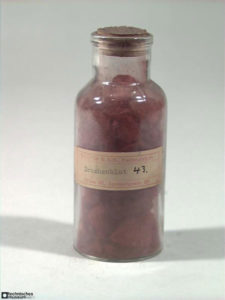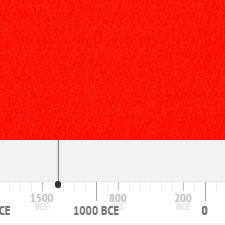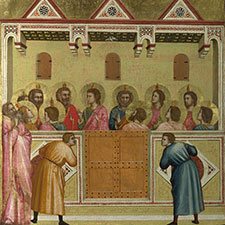Dragon's Blood
Natural organic pigmentComposition and Properties of Dragon’s Blood
Dragon’s blood is a red resin produced from a variety of trees growing in South East Asia, East Africa, Canary Islands, West Indies and also in South America. The constituents of this resin are numerous and differ according to their source.
The main colorant is a substance called dracorubine. It is noteworthy that the content of dracorubine in natural resin is less than 1%.

Pigment

Chemical formula of dracorubine

Painted swatch
Names
Alternative names
Chinese orange
Color Index
Natural red 31 (NR 31)
C.I. 75200, 75210
Word origin
The name comes from the dark red color of the pigment.
Drachenblut
German
Sang de dragon
French
Sangue di drago
Italian
Sangre de dragon
Spanish
Preparation
Dragon’s blood is secreted from the wounded trunk of the tree or can be found in the coverings of the fruit of certain rattan palms.
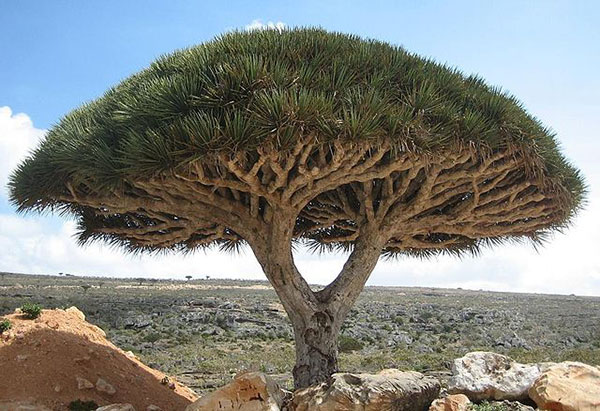
The tree Dracaena cinnabari growing on Socotra island in Yemen
References
(1) Kirby, J., Spring, M., Higgitt, C. ‘The Technology of Red Lake Pigment Manufacture: Study of the Dyestuff Substrate‘. National Gallery Technical Bulletin Vol 26, pp 71–87. Available as pdf.
(2) J. Kirby, M. Spring and C. Higgitt, The Technology of Eighteenth- and Nineteenth-Century Red Lake Pigments, National Gallery Technical Bulletin, Vol 28, 2007.
History of Use
Dragon’s blood was in use as a medicine and colorant since ancient times.
Examples of use
Giotto di Bondone and his workshop, ‘The Pentecost’ ca 1305-17

6 Orange-red flames over the heads of the Apostles: most probably a very rare red pigment, dragon’s blood, produced from resinous exudations of the tree with the same name and also from other species.
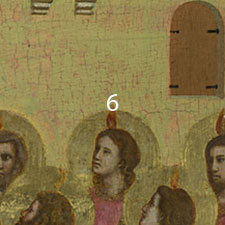
(1) David Bomford, Jill Dunkerton, Dillian Gordon, Ashok Roy, Jo Kirby, National Gallery Catalogues, The Italian Paintings before 1400′, London 2011, pp. 64–71.
Identification
IR Spectrum
IR Spectrum in: Ref (3), p. 5.
Raman Spectrum
Raman Spectrum in ref (1), p. 9 and ref (2), p. 15.
References
(1) Lucia Burgio, Robin J.H. Clark, Graham Martin, Emmanuel Pantos and Mark Roberts, A Multidisciplinary Approach to Pigment
Analysis: King’s Yellow and Dragon’s blood from the Winsor and Newton Pigment Box at the Victoria and Albert Museum, Proceedings of the Workshop on Structural Molecular Archaeology, Ettore, Majorana Centre, Erice, Sicily, 25-27 May 2002.
(2) Catherine M. Schmidt, Karen A. Trentelman, 1064 nm Dispersive Raman Micro-Spectroscopy For the In-situ Identification of Organic Red Colorants, e-Preservation Science, e-PS, 2009, 6, 10-21. Available as pdf.
(3) M. Pérez, K. Castro, M.D. Rodrígue, MA. Olazabal and J.M. Madariaga, A Critical Analysis Of Commercial Pigments. Available as doc.
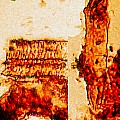
Microphotograph
image © Volker Emrath
Further Reading
References
(1) Deepika Gupta a, Bruce Bleakley b, Rajinder K. Gupta, Dragon’s blood: Botany, chemistry and therapeutic uses, Journal of Ethnopharmacology 115 (2008) 361–380. Available as pdf.
(2) Qingan Zheng, Min Xu, Chongren Yang, Dong Wang, Haizhou Li, Hongtao Zhu and Yingjun Zhang, A New Red Pigment from Chinese Dragon’s Blood, the Red Resin of Dracaena cochinchinensis, Bull. Korean Chem. Soc. 2012, Vol. 33, No. 12, http://dx.doi.org/10.5012/bkcs.2012.33.12.4204. Available as pdf.
(3) a) G. Cardillo, L. Merlini, G. Nasini and P. Salvadori, Constituents of Dragon’s blood. Part I. Structure and absolute configuration of new optically active flavans, J. Chem. Soc. C, 1971, 3967-3970, DOI: 10.1039/J39710003967. b) Alberto Arnone, Gianluca Nasini and Lucio Merlini, Constituents of ‘Dragon’s blood.’ Part 4. Dracoflavan A, a novel secotriflavanoid, J. Chem. Soc., Perkin Trans. 1, 1990, 2637-2640 , DOI: 10.1039/P19900002637.
(4 a) Alexander Robertson and W. B. Whalley, The pigments of “dragon’s blood” resin. Part II. A synthesis of dracorhodin, J. Chem. Soc., 1950, 1882-1884, DOI: 10.1039/JR9500001882. b) Alexander Robertson, W. B. Whalley and J. Yates, The pigments of “dragon’s blood” resins. Part III. The constitution of dracorubin, J. Chem. Soc., 1950, 3117-3123, DOI: 10.1039/JR9500003117. c) P. Broadbent, Alexander Robertson and W. B. Whalley, The pigments of “Dragon’s blood” resin. Part IV. The oxidation of some anhydro-7-hydroxybenzopyranols, J. Chem. Soc., 1952, 4957-4959, DOI: 10.1039/JR9520004957 d) Alexander Robertson, V. Venkateswarlu and W. B. Whalley, The pigments of “dragon’s blood” resin. Part V. Some flavans, J. Chem. Soc., 1954, 3137-3142, DOI: 10.1039/JR9540003137. e) N. B. Dean and W. B. Whalley, The pigments of “dragon’s blood” resin. Part VI. 3 : 5-Dihydroxydiphenyl ether, J. Chem. Soc., 1954, 4638-4641, DOI: 10.1039/JR9540004638. f) A. A. Olaniyi, J. W. Powell and W. B. Whalley, The pigments of ‘dragon’s blood’ resin. Part VII. Synthesis of (±)-draconol, (±)-O-methyldraconol, (±)-O-methylisodraconol, and derivatives; the structure of dracorubin, J. Chem. Soc., Perkin Trans. 1, 1973, 179-184, DOI: 10.1039/P19730000179. g) Evans O. P. Agbakwuru and W. Basil Whalley, The pigments of ‘dragon’s blood’ resin. Part VIII. Synthesis of (±)-dracorubin and of (±)-nordracorubin, J. Chem. Soc., Perkin Trans. 1, 1976, 1392-1394, DOI: 10.1039/P19760001392.
S. Muntwyler, J. Lipscher, HP. Schneider, Das Farbenbuch, 2nd. Ed., 2023, alataverlag Elsau, pp. 156-157.

